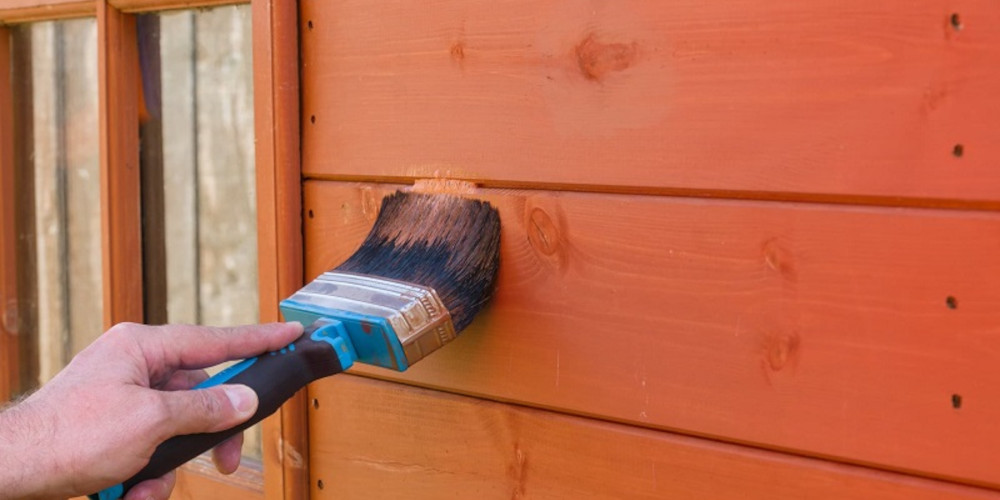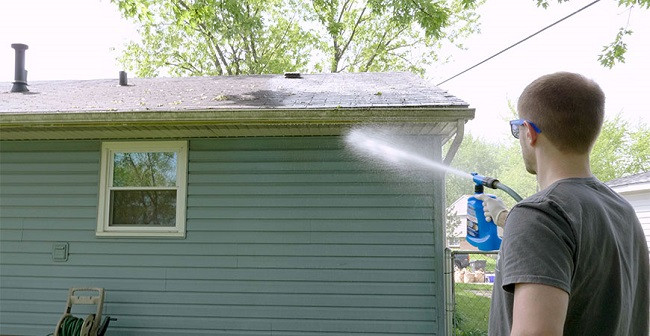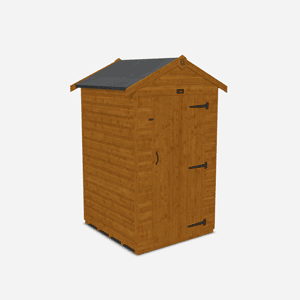How to Paint a Shed or Summerhouse
Published: 09/09/2021

Key reasons for painting a shed include sprucing up the look of your garden, protecting the building from the elements and prolonging its life – and we’re guessing you’re here for one or both of these reasons. It’s with this in mind that this post shows you how to paint a shed step by step. During this process, we aim to answer the following questions:
- Is my shed worth painting?
- How do you prepare a shed for painting?
- What kind of paint do you use on a shed?
- Can I paint over a stained shed?
- Do I need to use a shed primer paint?
- Should you paint the inside of a shed?
- What’s the best weatherproof paint for a shed?
- Can you paint a pressure-treated shed?
Note 1: In this post, we talk about how to paint a wooden shed (rather than a metal one). Note 2: As the title of this post suggests, this information applies just as much to summerhouses and it does to sheds. So, let’s get started. Here are nine steps to painting your shed (and doing it right):
1. Work out whether you should paint your shed (or whether it’s worth it)

This is a common starting point in many of the guides on the Tiger Sheds blog. This is because we only recommend doing work on your shed if it’s in good condition. If the shed is decades old, has large rotten patches, or is suffering from a sunken roof or distorted window cavities, then there’s no point spending all that time and money trying to fix a shed that’s beyond repair. But if you’ve just bought a new shed or it’s just a couple of years old (and you’ve looked after it well), then it’s fine to paint or repaint it.
Can you paint a pressure-treated shed?
Yes, you can! While you shouldn’t paint freshly pressure-treated timber because it can trap some of the moisture and make the paint prone to peeling, pressure-treated sheds are fine to paint. Why? Because they’ve had time to dry.
2. Gather what you need

The tools and other items you need to depend on your situation (more on this in a moment). However, here are the core items you need to get started:
- Exterior wood paints (including primer) or stain
- Wood paintbrush or roller
- Masking tape
- Newspaper
- Face mask
- Disposable gloves
- Dust sheet
Why do we say the above are core items? Because whether you’re painting a new shed (fresh from the manufacturer) or an older one, you’ll need all the items in the list above. But if your shed is older shed, you may also require some (or all) of the following items:
- Wire brush
- Outdoor cleaning solution
- Hammer and nails
- Wood sealant
Now you have an idea what you need to paint a shed, how do you choose between some of the optional items (such as wood paint or shed stain, or wood paintbrush or roller). Well, let’s take a look…
Is it better to stain or paint a shed?
On one level, the question of whether to stain or paint a shed is your decision – it’s entirely up to you. Wooden shed stain is easier to apply. Plus, some people prefer the look of stain. That said, shed paint comes in more colours and is easier to clean – dust, dirt and debris is less likely to stick to paint. What’s more, paint also tends to last longer than solid stain and provides better protection from sun damage.
What’s the best weatherproof paint for a shed?
Assuming you’ve decided to use shed paint (that’s what this article is about, after all), what kind of paint do you use on a shed? Most experts agree that the best shed paint is 100% acrylic latex paint. This is because it’s both waterproof and weatherproof. We’d go as far to say that when it comes to a waterproof paint, you can’t beat it.
Can I paint a shed with a roller?

On the question whether you CAN paint a shed with a roller, the answer is yes. But SHOULD you do so? By all means, use a roller to paint large areas– this will help save time and help ensure you can achieve an even finish. That said, we recommend using a paintbrush for nooks, crannies, and other small areas.
3. Make any necessary repairs

If you have a new shed, you shouldn’t need to worry about repairing cracks in the wood, replacing rotten sections, or any other type of repair work – you have a right to demand that your new shed is in pristine condition when it arrives at your property. But if you have an older shed, use wood filler to close up any cracks or gaps. This will prolong the life of your shed and keep the paint free from moisture, which in turn will help prevent it from peeling. If any part of the shed’s exterior is blighted by rot or any other form of decay, either replace the bad sections with healthy timber before painting the shed, or buy a new shed.
4. Treat the building

Most sheds come with a water-based treatment designed to protect your shed from the elements for up to a month. As a result, we recommend treating it as soon as possible – and at least once a year after that. This will help protect your shed from bad weather and should help the building last longer. For the best shed preserver on the market, go to this page.
5. Clean it!

Again, you shouldn’t need to bother cleaning the shed if it’s brand new – so you can skip this step and go the next one. But if your shed has been out in the open for even a little while, use your wire brush to remove any ground-in dirt, cobwebs or flaking paint.
6. Cover it!

Cover the any surfaces you don’t want to paint with newspaper and masking tape. This may include windows, metalwork or surfaces to wish to paint in a different colour at a later stage. Use your dust sheet to cover any plants that you don’t (or can’t) move or cut away.
7. Prime it!
One question we hear a lot is “do I need to prime my shed before painting?” Well, you don’t have to prime it, but we recommend you do – and there are two main reasons for this: Firstly, shed primer make it easier to create a more even finish. And secondly, priming paint gives your shed an extra layer of protection against the elements – potentially helping to prolong both the life of your shed and its paint job!
8. Paint your shed

Use the wood brush or roller to apply a thick, yet even layer of the paint. Work on all the trimmings first and pay particular attention to any vertical areas, on which you should apply vertical strokes. Next, paint each board – starting at the top and moving down. Apply your brush strokes in same direction as the grain. To avoid drips, make sure you don’t use too much paint on the end of your brush. If you find any drips on edges, dab the brush on to the area(s) so that the paint soaks into the wood.
Should you paint the inside of a shed?
That’s entirely up to you – you don’t NEED to paint your shed. That said, painting the interior can help seal the wood and make it easier to clean, as well as (potentially) making it look nicer.
Can I paint over a stained shed?
Well, yes and no. If the shed has been stained properly, a stained shed will have been coated with some form of lacquer or varnish to maintain it. For this reason, you’ll need to remove the lacquer with sandpaper before painting it.
9. Leave it to dry
Before taking off any masking and other coverings, leave the paint to dry for at least four hours. After that, remove the covers and enjoy your newly spruced and freshly painted shed! 









